Analyzing Flexible Work Arrangements Impact on Job Satisfaction
VerifiedAdded on 2023/06/11
|51
|13679
|93
Report
AI Summary
This report investigates the relationship between flexible work arrangements (FWA) and employee job satisfaction, focusing on the mediating role of work-family enrichment. It explores how FWAs, such as flexplace and flextime, impact employee satisfaction and organizational performance. The research includes a literature review, research methodology detailing data collection and analysis, empirical results from hypothesis testing, and a discussion of the findings. The study examines the impact of FWAs on employee satisfaction and engagement, considering factors like work-family balance and well-being. It also addresses the limitations of the research and provides a conclusion based on the empirical findings. The report utilizes questionnaires and statistical analysis to assess the relationships between FWA, job satisfaction, and work-family enrichment. Desklib provides access to this and other solved assignments for students.
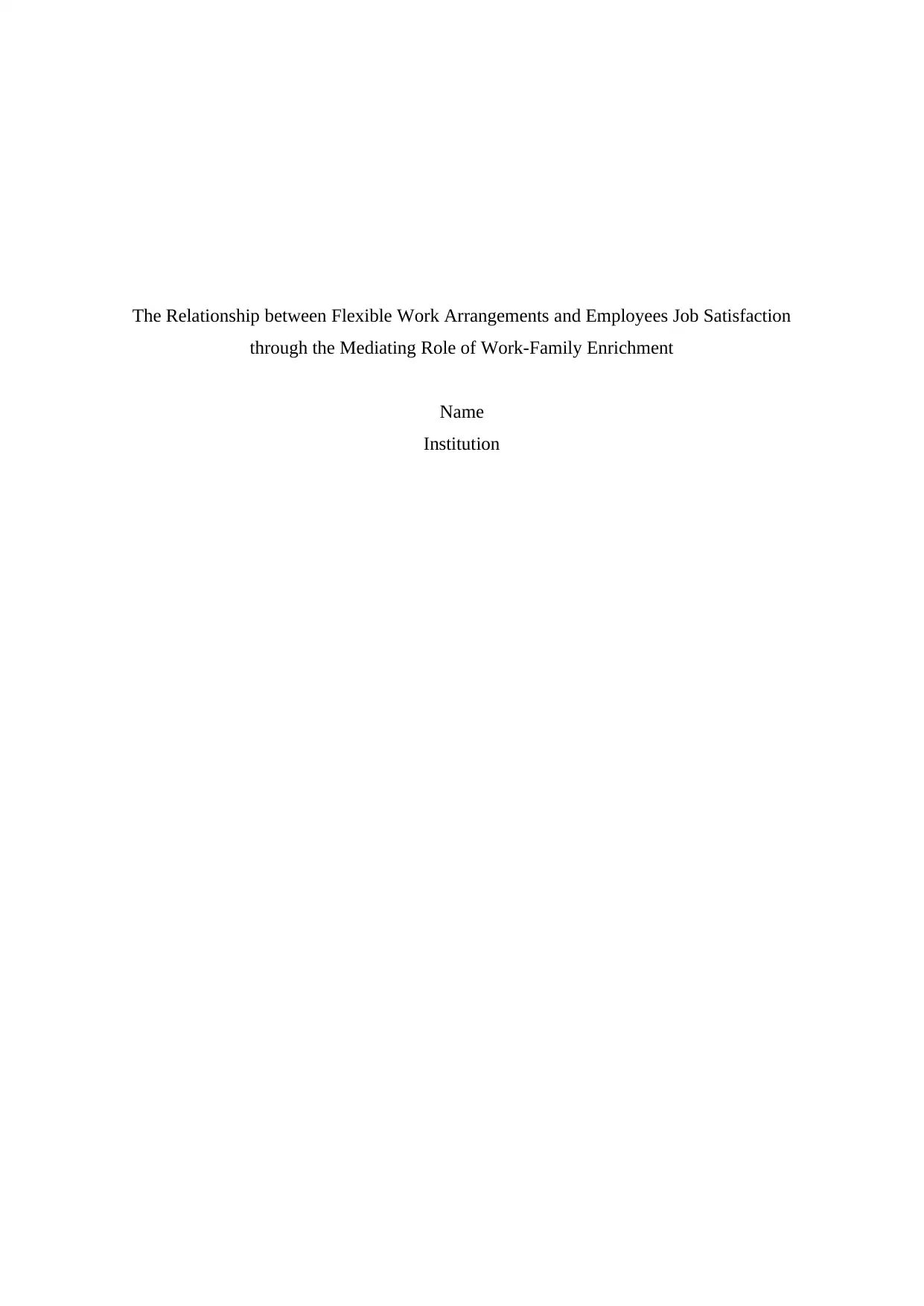
The Relationship between Flexible Work Arrangements and Employees Job Satisfaction
through the Mediating Role of Work-Family Enrichment
Name
Institution
through the Mediating Role of Work-Family Enrichment
Name
Institution
Paraphrase This Document
Need a fresh take? Get an instant paraphrase of this document with our AI Paraphraser
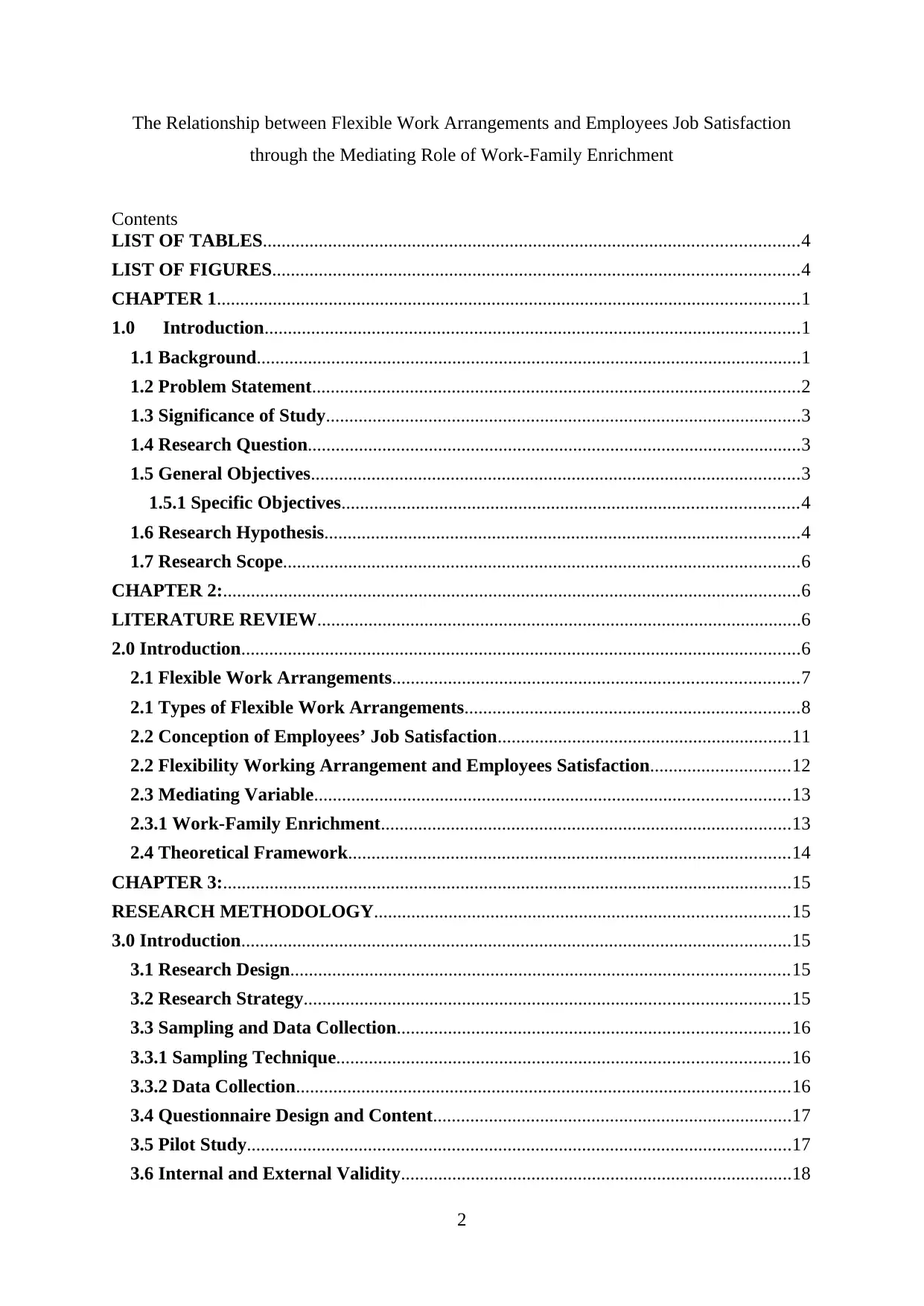
The Relationship between Flexible Work Arrangements and Employees Job Satisfaction
through the Mediating Role of Work-Family Enrichment
Contents
LIST OF TABLES...................................................................................................................4
LIST OF FIGURES.................................................................................................................4
CHAPTER 1.............................................................................................................................1
1.0 Introduction...................................................................................................................1
1.1 Background.....................................................................................................................1
1.2 Problem Statement.........................................................................................................2
1.3 Significance of Study......................................................................................................3
1.4 Research Question..........................................................................................................3
1.5 General Objectives.........................................................................................................3
1.5.1 Specific Objectives..................................................................................................4
1.6 Research Hypothesis......................................................................................................4
1.7 Research Scope...............................................................................................................6
CHAPTER 2:............................................................................................................................6
LITERATURE REVIEW........................................................................................................6
2.0 Introduction........................................................................................................................6
2.1 Flexible Work Arrangements.......................................................................................7
2.1 Types of Flexible Work Arrangements........................................................................8
2.2 Conception of Employees’ Job Satisfaction...............................................................11
2.2 Flexibility Working Arrangement and Employees Satisfaction..............................12
2.3 Mediating Variable......................................................................................................13
2.3.1 Work-Family Enrichment........................................................................................13
2.4 Theoretical Framework...............................................................................................14
CHAPTER 3:..........................................................................................................................15
RESEARCH METHODOLOGY.........................................................................................15
3.0 Introduction......................................................................................................................15
3.1 Research Design...........................................................................................................15
3.2 Research Strategy........................................................................................................15
3.3 Sampling and Data Collection....................................................................................16
3.3.1 Sampling Technique.................................................................................................16
3.3.2 Data Collection..........................................................................................................16
3.4 Questionnaire Design and Content.............................................................................17
3.5 Pilot Study.....................................................................................................................17
3.6 Internal and External Validity....................................................................................18
2
through the Mediating Role of Work-Family Enrichment
Contents
LIST OF TABLES...................................................................................................................4
LIST OF FIGURES.................................................................................................................4
CHAPTER 1.............................................................................................................................1
1.0 Introduction...................................................................................................................1
1.1 Background.....................................................................................................................1
1.2 Problem Statement.........................................................................................................2
1.3 Significance of Study......................................................................................................3
1.4 Research Question..........................................................................................................3
1.5 General Objectives.........................................................................................................3
1.5.1 Specific Objectives..................................................................................................4
1.6 Research Hypothesis......................................................................................................4
1.7 Research Scope...............................................................................................................6
CHAPTER 2:............................................................................................................................6
LITERATURE REVIEW........................................................................................................6
2.0 Introduction........................................................................................................................6
2.1 Flexible Work Arrangements.......................................................................................7
2.1 Types of Flexible Work Arrangements........................................................................8
2.2 Conception of Employees’ Job Satisfaction...............................................................11
2.2 Flexibility Working Arrangement and Employees Satisfaction..............................12
2.3 Mediating Variable......................................................................................................13
2.3.1 Work-Family Enrichment........................................................................................13
2.4 Theoretical Framework...............................................................................................14
CHAPTER 3:..........................................................................................................................15
RESEARCH METHODOLOGY.........................................................................................15
3.0 Introduction......................................................................................................................15
3.1 Research Design...........................................................................................................15
3.2 Research Strategy........................................................................................................15
3.3 Sampling and Data Collection....................................................................................16
3.3.1 Sampling Technique.................................................................................................16
3.3.2 Data Collection..........................................................................................................16
3.4 Questionnaire Design and Content.............................................................................17
3.5 Pilot Study.....................................................................................................................17
3.6 Internal and External Validity....................................................................................18
2
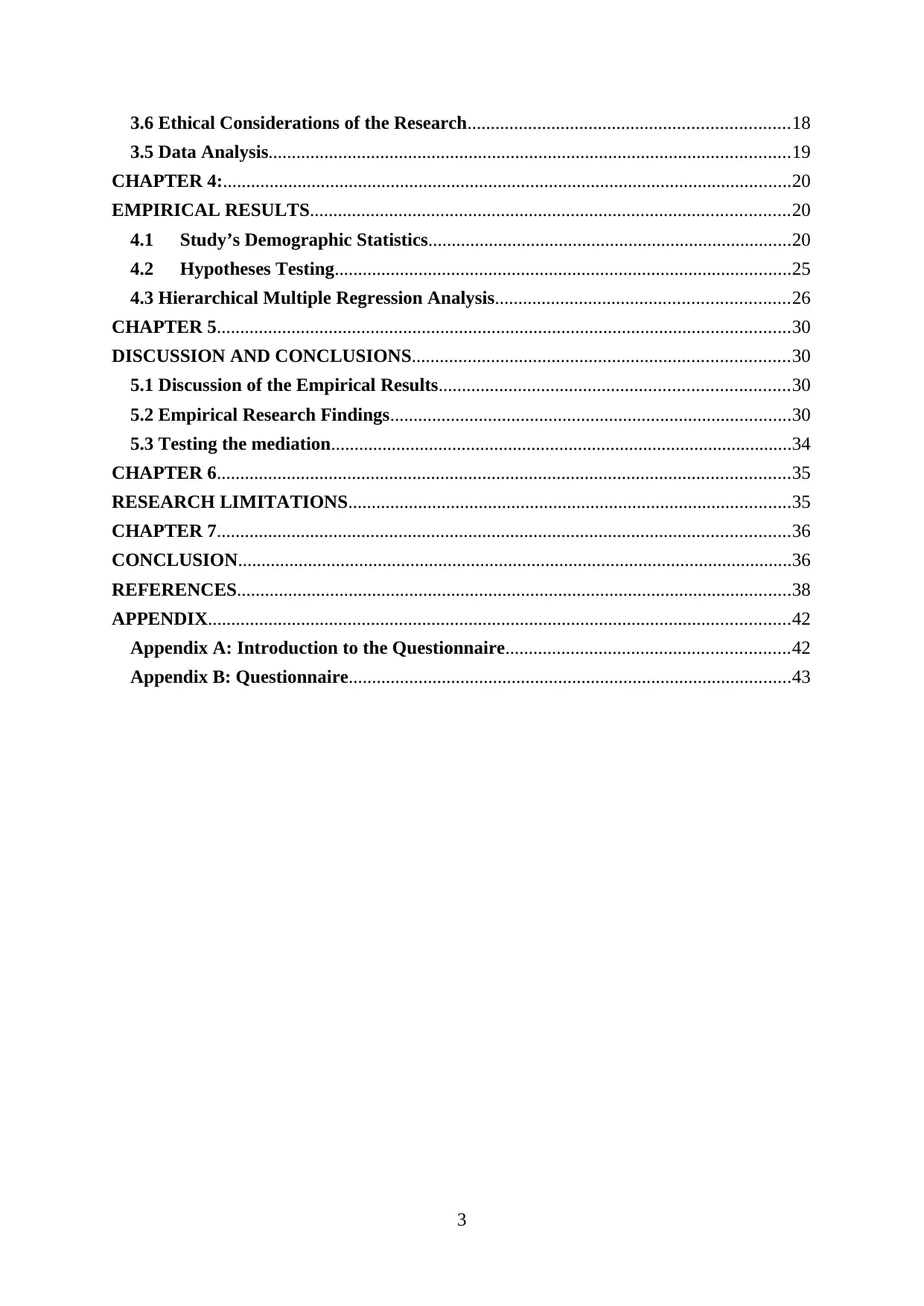
3.6 Ethical Considerations of the Research.....................................................................18
3.5 Data Analysis................................................................................................................19
CHAPTER 4:..........................................................................................................................20
EMPIRICAL RESULTS.......................................................................................................20
4.1 Study’s Demographic Statistics..............................................................................20
4.2 Hypotheses Testing..................................................................................................25
4.3 Hierarchical Multiple Regression Analysis...............................................................26
CHAPTER 5...........................................................................................................................30
DISCUSSION AND CONCLUSIONS.................................................................................30
5.1 Discussion of the Empirical Results...........................................................................30
5.2 Empirical Research Findings......................................................................................30
5.3 Testing the mediation...................................................................................................34
CHAPTER 6...........................................................................................................................35
RESEARCH LIMITATIONS...............................................................................................35
CHAPTER 7...........................................................................................................................36
CONCLUSION.......................................................................................................................36
REFERENCES.......................................................................................................................38
APPENDIX.............................................................................................................................42
Appendix A: Introduction to the Questionnaire.............................................................42
Appendix B: Questionnaire...............................................................................................43
3
3.5 Data Analysis................................................................................................................19
CHAPTER 4:..........................................................................................................................20
EMPIRICAL RESULTS.......................................................................................................20
4.1 Study’s Demographic Statistics..............................................................................20
4.2 Hypotheses Testing..................................................................................................25
4.3 Hierarchical Multiple Regression Analysis...............................................................26
CHAPTER 5...........................................................................................................................30
DISCUSSION AND CONCLUSIONS.................................................................................30
5.1 Discussion of the Empirical Results...........................................................................30
5.2 Empirical Research Findings......................................................................................30
5.3 Testing the mediation...................................................................................................34
CHAPTER 6...........................................................................................................................35
RESEARCH LIMITATIONS...............................................................................................35
CHAPTER 7...........................................................................................................................36
CONCLUSION.......................................................................................................................36
REFERENCES.......................................................................................................................38
APPENDIX.............................................................................................................................42
Appendix A: Introduction to the Questionnaire.............................................................42
Appendix B: Questionnaire...............................................................................................43
3
⊘ This is a preview!⊘
Do you want full access?
Subscribe today to unlock all pages.

Trusted by 1+ million students worldwide
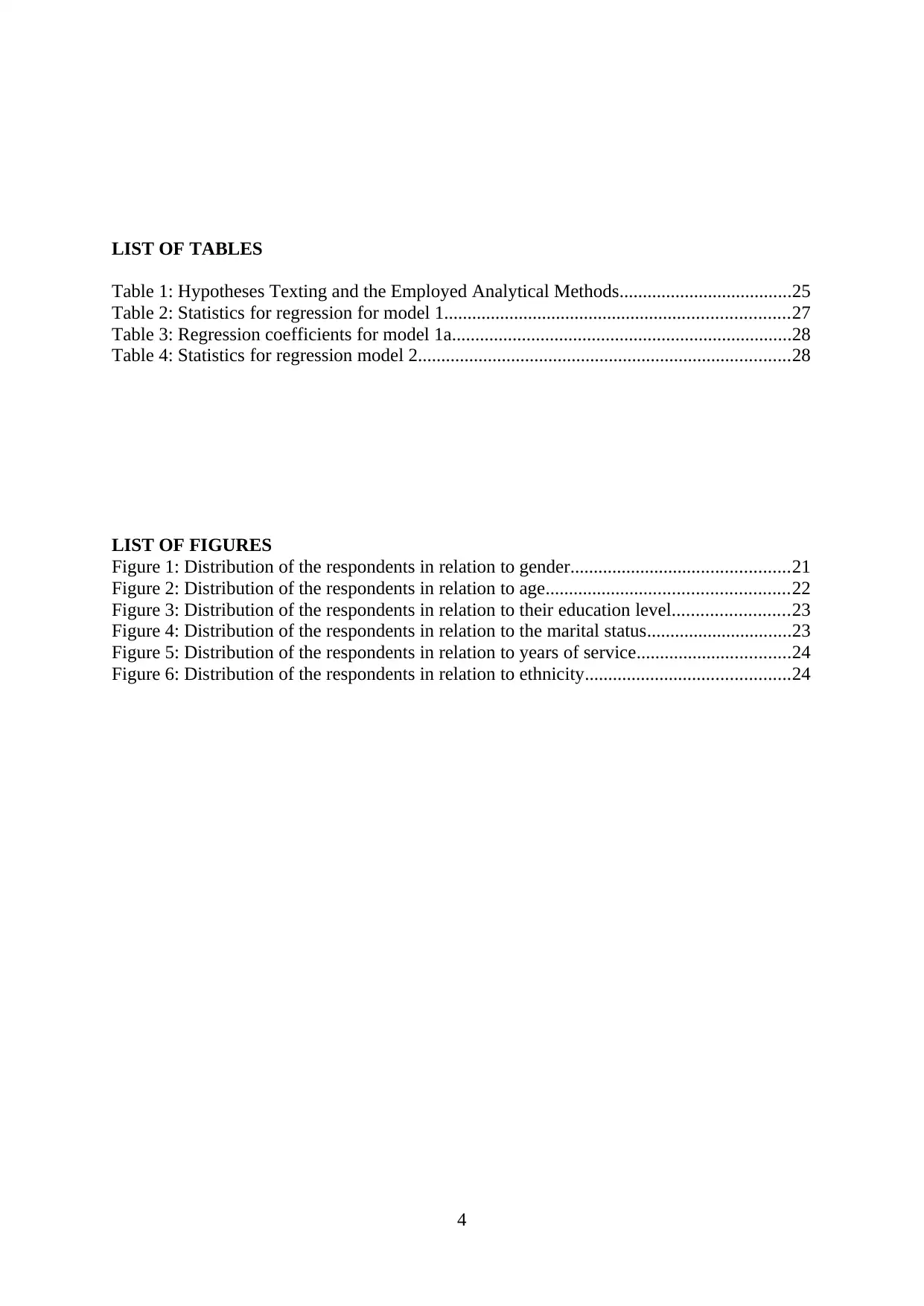
LIST OF TABLES
Table 1: Hypotheses Texting and the Employed Analytical Methods.....................................25
Table 2: Statistics for regression for model 1..........................................................................27
Table 3: Regression coefficients for model 1a.........................................................................28
Table 4: Statistics for regression model 2................................................................................28
LIST OF FIGURES
Figure 1: Distribution of the respondents in relation to gender...............................................21
Figure 2: Distribution of the respondents in relation to age....................................................22
Figure 3: Distribution of the respondents in relation to their education level.........................23
Figure 4: Distribution of the respondents in relation to the marital status...............................23
Figure 5: Distribution of the respondents in relation to years of service.................................24
Figure 6: Distribution of the respondents in relation to ethnicity............................................24
4
Table 1: Hypotheses Texting and the Employed Analytical Methods.....................................25
Table 2: Statistics for regression for model 1..........................................................................27
Table 3: Regression coefficients for model 1a.........................................................................28
Table 4: Statistics for regression model 2................................................................................28
LIST OF FIGURES
Figure 1: Distribution of the respondents in relation to gender...............................................21
Figure 2: Distribution of the respondents in relation to age....................................................22
Figure 3: Distribution of the respondents in relation to their education level.........................23
Figure 4: Distribution of the respondents in relation to the marital status...............................23
Figure 5: Distribution of the respondents in relation to years of service.................................24
Figure 6: Distribution of the respondents in relation to ethnicity............................................24
4
Paraphrase This Document
Need a fresh take? Get an instant paraphrase of this document with our AI Paraphraser

Running Head: FLEXIBLE WORK ARRANGEMENTS AND JOB SATISFACTION 1
CHAPTER 1
1.0 Introduction
Job satisfaction impacts both on the employer and employees, these impacts include work-
family engagements, career success, engagement, turnover rates, absenteeism, and the quality
of work. Adopting work flexibility arrangements at the places of works has been attributed
with improving job satisfaction (Thomas, 2014). In this study, the investigator builds on
existing literature and theories as he seeks to establish the relationships that is extant between
work flexibility arrangements and employees jobs satisfaction. This section details the
background of research, problem statement, and research question and research objectives. .
1.1 Background
The manners in which flexible working arrangements impacts works, and the subsequent
impacts on the bottom line, are of paramount interest to companies especially in gaining
competitive advantages amid increasing globalization activities. Notwithstanding, many
organizations are left to resolve if and how they will offer flexibility, and conclusions are
mostly based on how they observe such arrangements will impact their capacity to be
receptive to business needs. Flexibility in the places of works serves as a useful and critical
resource for workers, permitting them to control the duration, timing, and setting of carrying
out their job (Carlson, Grzywacz, & Michele Kacmar, 2010). Such arrangements are
repeatedly offered in hopes of enticing and retaining top talent through increasing employees,
work-life balance, job satisfaction, and organizational commitment (Albrecht, 2012). On top
of providing flexible work arrangements as a family-friendly advantage, scholars and public
activists have also called for organizations to provide flexible work arrangements in to help
promote employee well-being and health (Thomas, 2014 ) and to assist in addressing the
growing need of organizations to increase employees productivity occasioned by increased
level of satisfaction. Flexibility may materialize in the form of varying work locations or
CHAPTER 1
1.0 Introduction
Job satisfaction impacts both on the employer and employees, these impacts include work-
family engagements, career success, engagement, turnover rates, absenteeism, and the quality
of work. Adopting work flexibility arrangements at the places of works has been attributed
with improving job satisfaction (Thomas, 2014). In this study, the investigator builds on
existing literature and theories as he seeks to establish the relationships that is extant between
work flexibility arrangements and employees jobs satisfaction. This section details the
background of research, problem statement, and research question and research objectives. .
1.1 Background
The manners in which flexible working arrangements impacts works, and the subsequent
impacts on the bottom line, are of paramount interest to companies especially in gaining
competitive advantages amid increasing globalization activities. Notwithstanding, many
organizations are left to resolve if and how they will offer flexibility, and conclusions are
mostly based on how they observe such arrangements will impact their capacity to be
receptive to business needs. Flexibility in the places of works serves as a useful and critical
resource for workers, permitting them to control the duration, timing, and setting of carrying
out their job (Carlson, Grzywacz, & Michele Kacmar, 2010). Such arrangements are
repeatedly offered in hopes of enticing and retaining top talent through increasing employees,
work-life balance, job satisfaction, and organizational commitment (Albrecht, 2012). On top
of providing flexible work arrangements as a family-friendly advantage, scholars and public
activists have also called for organizations to provide flexible work arrangements in to help
promote employee well-being and health (Thomas, 2014 ) and to assist in addressing the
growing need of organizations to increase employees productivity occasioned by increased
level of satisfaction. Flexibility may materialize in the form of varying work locations or
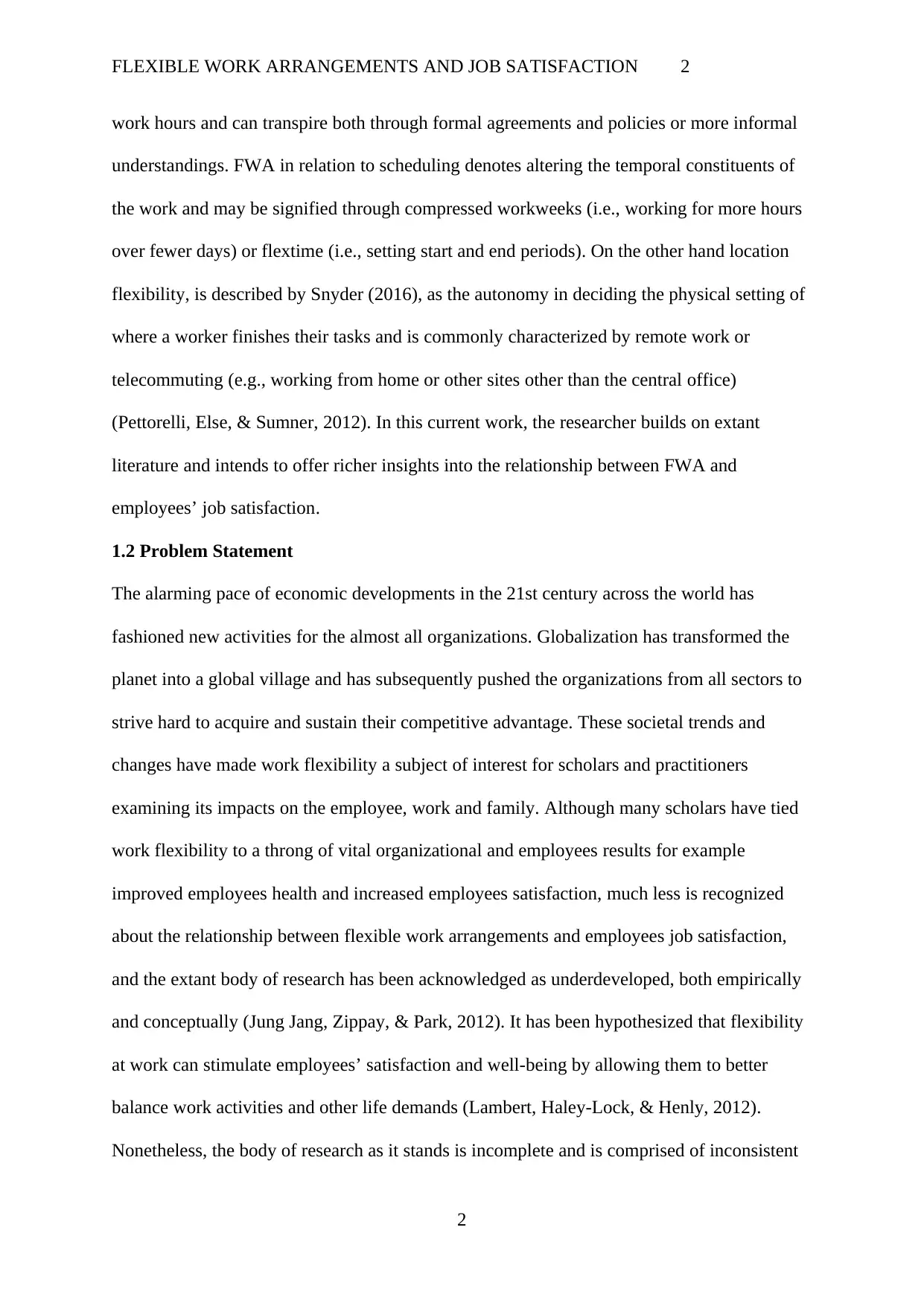
FLEXIBLE WORK ARRANGEMENTS AND JOB SATISFACTION 2
work hours and can transpire both through formal agreements and policies or more informal
understandings. FWA in relation to scheduling denotes altering the temporal constituents of
the work and may be signified through compressed workweeks (i.e., working for more hours
over fewer days) or flextime (i.e., setting start and end periods). On the other hand location
flexibility, is described by Snyder (2016), as the autonomy in deciding the physical setting of
where a worker finishes their tasks and is commonly characterized by remote work or
telecommuting (e.g., working from home or other sites other than the central office)
(Pettorelli, Else, & Sumner, 2012). In this current work, the researcher builds on extant
literature and intends to offer richer insights into the relationship between FWA and
employees’ job satisfaction.
1.2 Problem Statement
The alarming pace of economic developments in the 21st century across the world has
fashioned new activities for the almost all organizations. Globalization has transformed the
planet into a global village and has subsequently pushed the organizations from all sectors to
strive hard to acquire and sustain their competitive advantage. These societal trends and
changes have made work flexibility a subject of interest for scholars and practitioners
examining its impacts on the employee, work and family. Although many scholars have tied
work flexibility to a throng of vital organizational and employees results for example
improved employees health and increased employees satisfaction, much less is recognized
about the relationship between flexible work arrangements and employees job satisfaction,
and the extant body of research has been acknowledged as underdeveloped, both empirically
and conceptually (Jung Jang, Zippay, & Park, 2012). It has been hypothesized that flexibility
at work can stimulate employees’ satisfaction and well-being by allowing them to better
balance work activities and other life demands (Lambert, Haley-Lock, & Henly, 2012).
Nonetheless, the body of research as it stands is incomplete and is comprised of inconsistent
2
work hours and can transpire both through formal agreements and policies or more informal
understandings. FWA in relation to scheduling denotes altering the temporal constituents of
the work and may be signified through compressed workweeks (i.e., working for more hours
over fewer days) or flextime (i.e., setting start and end periods). On the other hand location
flexibility, is described by Snyder (2016), as the autonomy in deciding the physical setting of
where a worker finishes their tasks and is commonly characterized by remote work or
telecommuting (e.g., working from home or other sites other than the central office)
(Pettorelli, Else, & Sumner, 2012). In this current work, the researcher builds on extant
literature and intends to offer richer insights into the relationship between FWA and
employees’ job satisfaction.
1.2 Problem Statement
The alarming pace of economic developments in the 21st century across the world has
fashioned new activities for the almost all organizations. Globalization has transformed the
planet into a global village and has subsequently pushed the organizations from all sectors to
strive hard to acquire and sustain their competitive advantage. These societal trends and
changes have made work flexibility a subject of interest for scholars and practitioners
examining its impacts on the employee, work and family. Although many scholars have tied
work flexibility to a throng of vital organizational and employees results for example
improved employees health and increased employees satisfaction, much less is recognized
about the relationship between flexible work arrangements and employees job satisfaction,
and the extant body of research has been acknowledged as underdeveloped, both empirically
and conceptually (Jung Jang, Zippay, & Park, 2012). It has been hypothesized that flexibility
at work can stimulate employees’ satisfaction and well-being by allowing them to better
balance work activities and other life demands (Lambert, Haley-Lock, & Henly, 2012).
Nonetheless, the body of research as it stands is incomplete and is comprised of inconsistent
2
⊘ This is a preview!⊘
Do you want full access?
Subscribe today to unlock all pages.

Trusted by 1+ million students worldwide
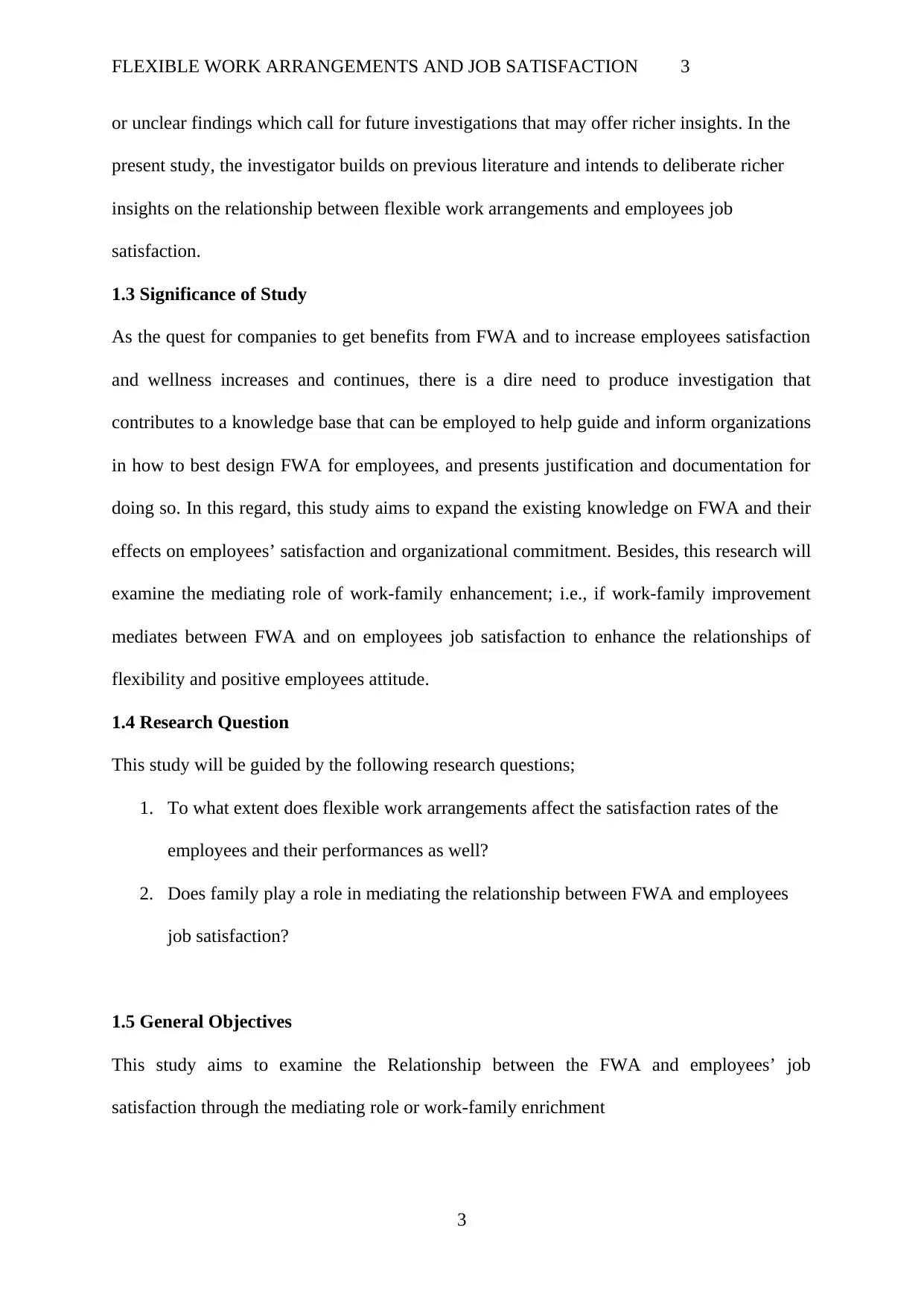
FLEXIBLE WORK ARRANGEMENTS AND JOB SATISFACTION 3
or unclear findings which call for future investigations that may offer richer insights. In the
present study, the investigator builds on previous literature and intends to deliberate richer
insights on the relationship between flexible work arrangements and employees job
satisfaction.
1.3 Significance of Study
As the quest for companies to get benefits from FWA and to increase employees satisfaction
and wellness increases and continues, there is a dire need to produce investigation that
contributes to a knowledge base that can be employed to help guide and inform organizations
in how to best design FWA for employees, and presents justification and documentation for
doing so. In this regard, this study aims to expand the existing knowledge on FWA and their
effects on employees’ satisfaction and organizational commitment. Besides, this research will
examine the mediating role of work-family enhancement; i.e., if work-family improvement
mediates between FWA and on employees job satisfaction to enhance the relationships of
flexibility and positive employees attitude.
1.4 Research Question
This study will be guided by the following research questions;
1. To what extent does flexible work arrangements affect the satisfaction rates of the
employees and their performances as well?
2. Does family play a role in mediating the relationship between FWA and employees
job satisfaction?
1.5 General Objectives
This study aims to examine the Relationship between the FWA and employees’ job
satisfaction through the mediating role or work-family enrichment
3
or unclear findings which call for future investigations that may offer richer insights. In the
present study, the investigator builds on previous literature and intends to deliberate richer
insights on the relationship between flexible work arrangements and employees job
satisfaction.
1.3 Significance of Study
As the quest for companies to get benefits from FWA and to increase employees satisfaction
and wellness increases and continues, there is a dire need to produce investigation that
contributes to a knowledge base that can be employed to help guide and inform organizations
in how to best design FWA for employees, and presents justification and documentation for
doing so. In this regard, this study aims to expand the existing knowledge on FWA and their
effects on employees’ satisfaction and organizational commitment. Besides, this research will
examine the mediating role of work-family enhancement; i.e., if work-family improvement
mediates between FWA and on employees job satisfaction to enhance the relationships of
flexibility and positive employees attitude.
1.4 Research Question
This study will be guided by the following research questions;
1. To what extent does flexible work arrangements affect the satisfaction rates of the
employees and their performances as well?
2. Does family play a role in mediating the relationship between FWA and employees
job satisfaction?
1.5 General Objectives
This study aims to examine the Relationship between the FWA and employees’ job
satisfaction through the mediating role or work-family enrichment
3
Paraphrase This Document
Need a fresh take? Get an instant paraphrase of this document with our AI Paraphraser
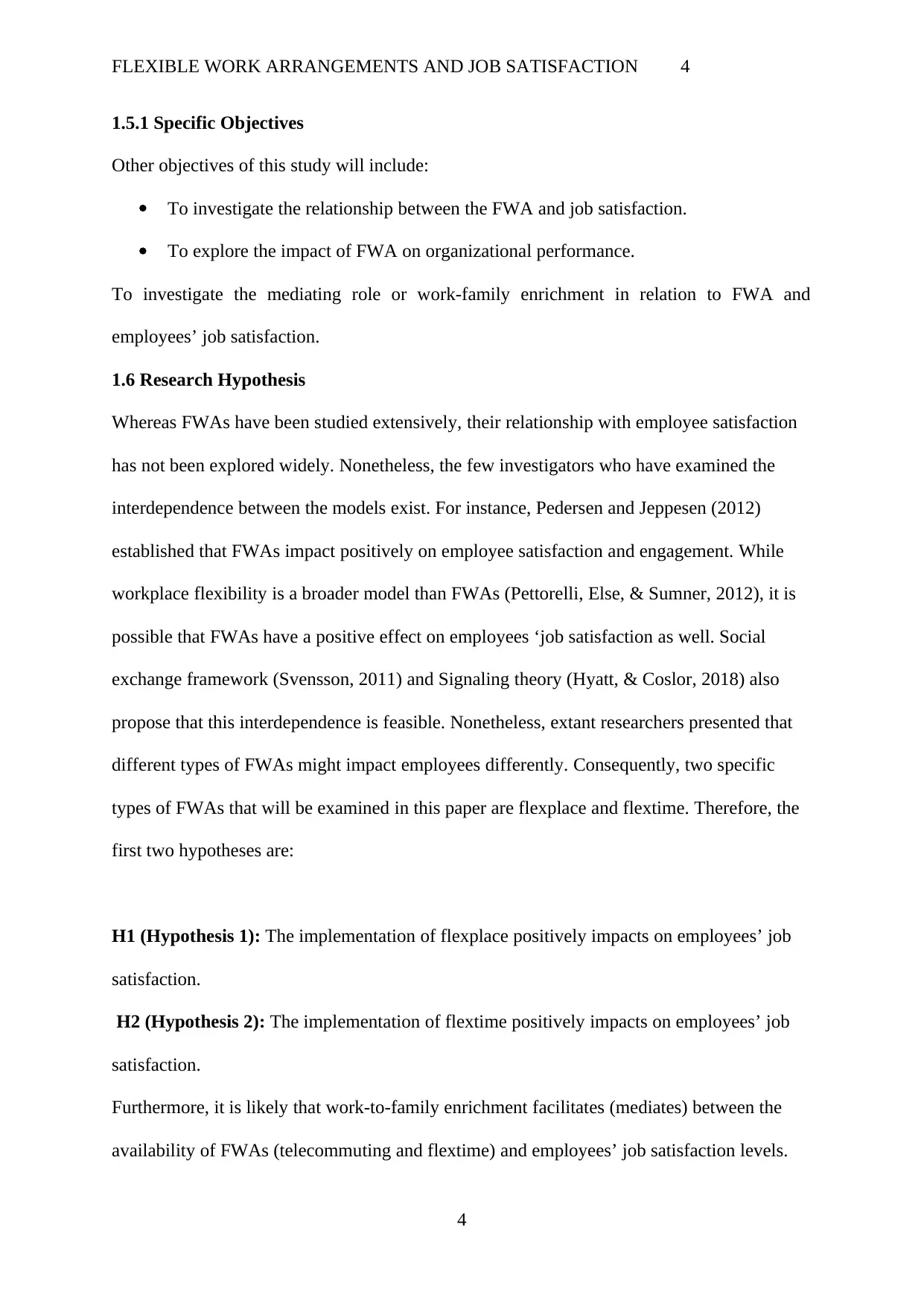
FLEXIBLE WORK ARRANGEMENTS AND JOB SATISFACTION 4
1.5.1 Specific Objectives
Other objectives of this study will include:
To investigate the relationship between the FWA and job satisfaction.
To explore the impact of FWA on organizational performance.
To investigate the mediating role or work-family enrichment in relation to FWA and
employees’ job satisfaction.
1.6 Research Hypothesis
Whereas FWAs have been studied extensively, their relationship with employee satisfaction
has not been explored widely. Nonetheless, the few investigators who have examined the
interdependence between the models exist. For instance, Pedersen and Jeppesen (2012)
established that FWAs impact positively on employee satisfaction and engagement. While
workplace flexibility is a broader model than FWAs (Pettorelli, Else, & Sumner, 2012), it is
possible that FWAs have a positive effect on employees ‘job satisfaction as well. Social
exchange framework (Svensson, 2011) and Signaling theory (Hyatt, & Coslor, 2018) also
propose that this interdependence is feasible. Nonetheless, extant researchers presented that
different types of FWAs might impact employees differently. Consequently, two specific
types of FWAs that will be examined in this paper are flexplace and flextime. Therefore, the
first two hypotheses are:
H1 (Hypothesis 1): The implementation of flexplace positively impacts on employees’ job
satisfaction.
H2 (Hypothesis 2): The implementation of flextime positively impacts on employees’ job
satisfaction.
Furthermore, it is likely that work-to-family enrichment facilitates (mediates) between the
availability of FWAs (telecommuting and flextime) and employees’ job satisfaction levels.
4
1.5.1 Specific Objectives
Other objectives of this study will include:
To investigate the relationship between the FWA and job satisfaction.
To explore the impact of FWA on organizational performance.
To investigate the mediating role or work-family enrichment in relation to FWA and
employees’ job satisfaction.
1.6 Research Hypothesis
Whereas FWAs have been studied extensively, their relationship with employee satisfaction
has not been explored widely. Nonetheless, the few investigators who have examined the
interdependence between the models exist. For instance, Pedersen and Jeppesen (2012)
established that FWAs impact positively on employee satisfaction and engagement. While
workplace flexibility is a broader model than FWAs (Pettorelli, Else, & Sumner, 2012), it is
possible that FWAs have a positive effect on employees ‘job satisfaction as well. Social
exchange framework (Svensson, 2011) and Signaling theory (Hyatt, & Coslor, 2018) also
propose that this interdependence is feasible. Nonetheless, extant researchers presented that
different types of FWAs might impact employees differently. Consequently, two specific
types of FWAs that will be examined in this paper are flexplace and flextime. Therefore, the
first two hypotheses are:
H1 (Hypothesis 1): The implementation of flexplace positively impacts on employees’ job
satisfaction.
H2 (Hypothesis 2): The implementation of flextime positively impacts on employees’ job
satisfaction.
Furthermore, it is likely that work-to-family enrichment facilitates (mediates) between the
availability of FWAs (telecommuting and flextime) and employees’ job satisfaction levels.
4
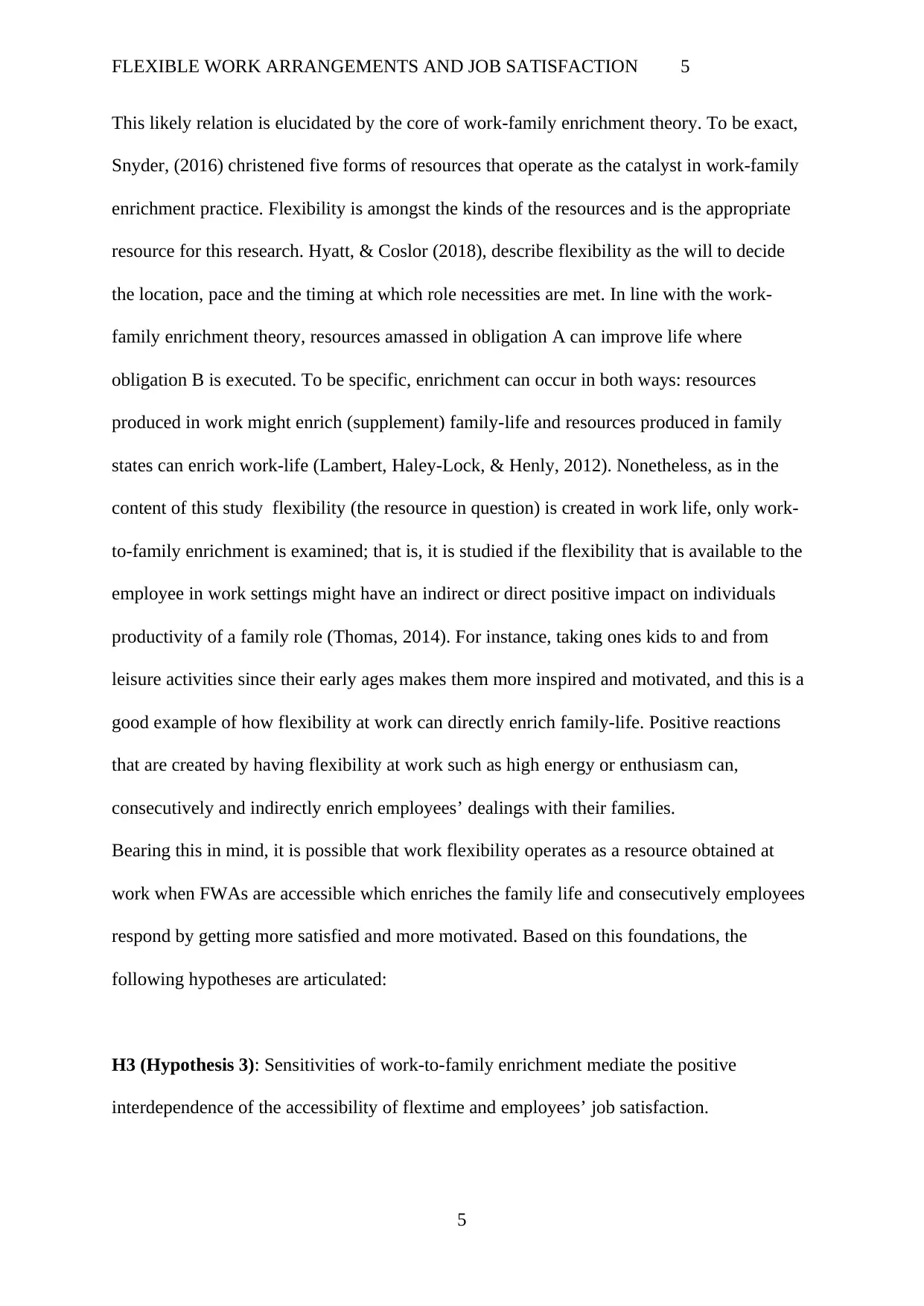
FLEXIBLE WORK ARRANGEMENTS AND JOB SATISFACTION 5
This likely relation is elucidated by the core of work-family enrichment theory. To be exact,
Snyder, (2016) christened five forms of resources that operate as the catalyst in work-family
enrichment practice. Flexibility is amongst the kinds of the resources and is the appropriate
resource for this research. Hyatt, & Coslor (2018), describe flexibility as the will to decide
the location, pace and the timing at which role necessities are met. In line with the work-
family enrichment theory, resources amassed in obligation A can improve life where
obligation B is executed. To be specific, enrichment can occur in both ways: resources
produced in work might enrich (supplement) family-life and resources produced in family
states can enrich work-life (Lambert, Haley-Lock, & Henly, 2012). Nonetheless, as in the
content of this study flexibility (the resource in question) is created in work life, only work-
to-family enrichment is examined; that is, it is studied if the flexibility that is available to the
employee in work settings might have an indirect or direct positive impact on individuals
productivity of a family role (Thomas, 2014). For instance, taking ones kids to and from
leisure activities since their early ages makes them more inspired and motivated, and this is a
good example of how flexibility at work can directly enrich family-life. Positive reactions
that are created by having flexibility at work such as high energy or enthusiasm can,
consecutively and indirectly enrich employees’ dealings with their families.
Bearing this in mind, it is possible that work flexibility operates as a resource obtained at
work when FWAs are accessible which enriches the family life and consecutively employees
respond by getting more satisfied and more motivated. Based on this foundations, the
following hypotheses are articulated:
H3 (Hypothesis 3): Sensitivities of work-to-family enrichment mediate the positive
interdependence of the accessibility of flextime and employees’ job satisfaction.
5
This likely relation is elucidated by the core of work-family enrichment theory. To be exact,
Snyder, (2016) christened five forms of resources that operate as the catalyst in work-family
enrichment practice. Flexibility is amongst the kinds of the resources and is the appropriate
resource for this research. Hyatt, & Coslor (2018), describe flexibility as the will to decide
the location, pace and the timing at which role necessities are met. In line with the work-
family enrichment theory, resources amassed in obligation A can improve life where
obligation B is executed. To be specific, enrichment can occur in both ways: resources
produced in work might enrich (supplement) family-life and resources produced in family
states can enrich work-life (Lambert, Haley-Lock, & Henly, 2012). Nonetheless, as in the
content of this study flexibility (the resource in question) is created in work life, only work-
to-family enrichment is examined; that is, it is studied if the flexibility that is available to the
employee in work settings might have an indirect or direct positive impact on individuals
productivity of a family role (Thomas, 2014). For instance, taking ones kids to and from
leisure activities since their early ages makes them more inspired and motivated, and this is a
good example of how flexibility at work can directly enrich family-life. Positive reactions
that are created by having flexibility at work such as high energy or enthusiasm can,
consecutively and indirectly enrich employees’ dealings with their families.
Bearing this in mind, it is possible that work flexibility operates as a resource obtained at
work when FWAs are accessible which enriches the family life and consecutively employees
respond by getting more satisfied and more motivated. Based on this foundations, the
following hypotheses are articulated:
H3 (Hypothesis 3): Sensitivities of work-to-family enrichment mediate the positive
interdependence of the accessibility of flextime and employees’ job satisfaction.
5
⊘ This is a preview!⊘
Do you want full access?
Subscribe today to unlock all pages.

Trusted by 1+ million students worldwide
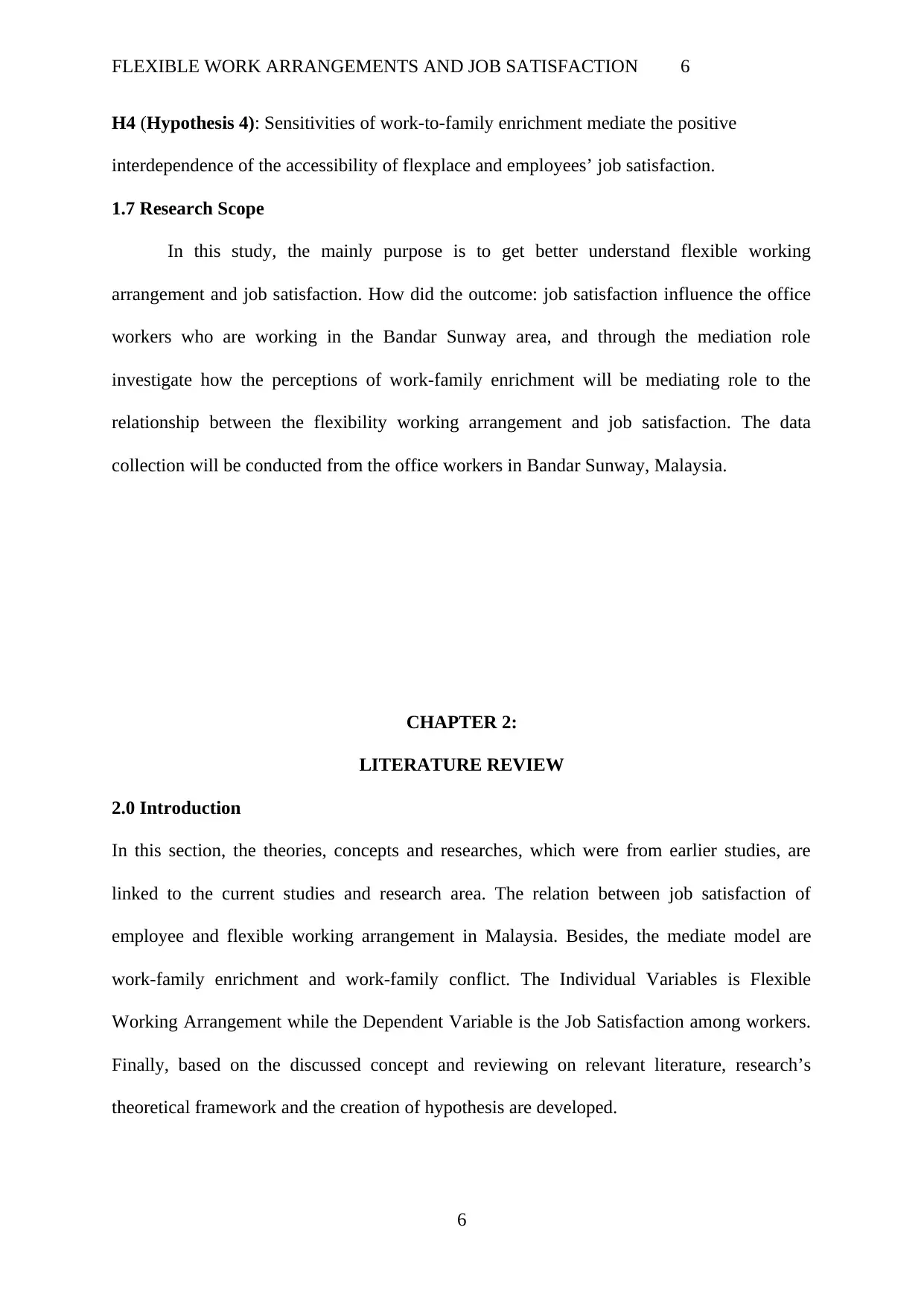
FLEXIBLE WORK ARRANGEMENTS AND JOB SATISFACTION 6
H4 (Hypothesis 4): Sensitivities of work-to-family enrichment mediate the positive
interdependence of the accessibility of flexplace and employees’ job satisfaction.
1.7 Research Scope
In this study, the mainly purpose is to get better understand flexible working
arrangement and job satisfaction. How did the outcome: job satisfaction influence the office
workers who are working in the Bandar Sunway area, and through the mediation role
investigate how the perceptions of work-family enrichment will be mediating role to the
relationship between the flexibility working arrangement and job satisfaction. The data
collection will be conducted from the office workers in Bandar Sunway, Malaysia.
CHAPTER 2:
LITERATURE REVIEW
2.0 Introduction
In this section, the theories, concepts and researches, which were from earlier studies, are
linked to the current studies and research area. The relation between job satisfaction of
employee and flexible working arrangement in Malaysia. Besides, the mediate model are
work-family enrichment and work-family conflict. The Individual Variables is Flexible
Working Arrangement while the Dependent Variable is the Job Satisfaction among workers.
Finally, based on the discussed concept and reviewing on relevant literature, research’s
theoretical framework and the creation of hypothesis are developed.
6
H4 (Hypothesis 4): Sensitivities of work-to-family enrichment mediate the positive
interdependence of the accessibility of flexplace and employees’ job satisfaction.
1.7 Research Scope
In this study, the mainly purpose is to get better understand flexible working
arrangement and job satisfaction. How did the outcome: job satisfaction influence the office
workers who are working in the Bandar Sunway area, and through the mediation role
investigate how the perceptions of work-family enrichment will be mediating role to the
relationship between the flexibility working arrangement and job satisfaction. The data
collection will be conducted from the office workers in Bandar Sunway, Malaysia.
CHAPTER 2:
LITERATURE REVIEW
2.0 Introduction
In this section, the theories, concepts and researches, which were from earlier studies, are
linked to the current studies and research area. The relation between job satisfaction of
employee and flexible working arrangement in Malaysia. Besides, the mediate model are
work-family enrichment and work-family conflict. The Individual Variables is Flexible
Working Arrangement while the Dependent Variable is the Job Satisfaction among workers.
Finally, based on the discussed concept and reviewing on relevant literature, research’s
theoretical framework and the creation of hypothesis are developed.
6
Paraphrase This Document
Need a fresh take? Get an instant paraphrase of this document with our AI Paraphraser
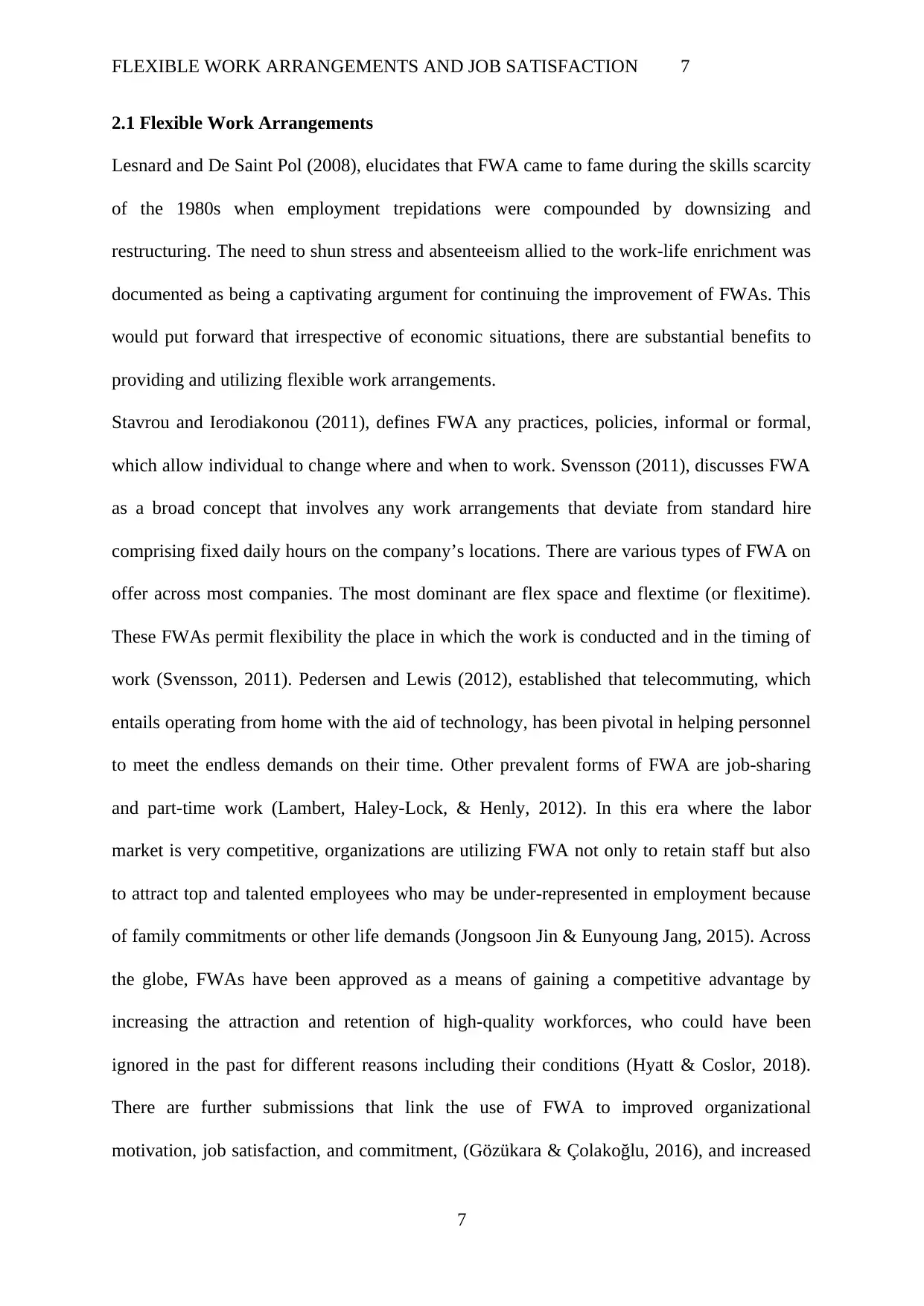
FLEXIBLE WORK ARRANGEMENTS AND JOB SATISFACTION 7
2.1 Flexible Work Arrangements
Lesnard and De Saint Pol (2008), elucidates that FWA came to fame during the skills scarcity
of the 1980s when employment trepidations were compounded by downsizing and
restructuring. The need to shun stress and absenteeism allied to the work-life enrichment was
documented as being a captivating argument for continuing the improvement of FWAs. This
would put forward that irrespective of economic situations, there are substantial benefits to
providing and utilizing flexible work arrangements.
Stavrou and Ierodiakonou (2011), defines FWA any practices, policies, informal or formal,
which allow individual to change where and when to work. Svensson (2011), discusses FWA
as a broad concept that involves any work arrangements that deviate from standard hire
comprising fixed daily hours on the company’s locations. There are various types of FWA on
offer across most companies. The most dominant are flex space and flextime (or flexitime).
These FWAs permit flexibility the place in which the work is conducted and in the timing of
work (Svensson, 2011). Pedersen and Lewis (2012), established that telecommuting, which
entails operating from home with the aid of technology, has been pivotal in helping personnel
to meet the endless demands on their time. Other prevalent forms of FWA are job-sharing
and part-time work (Lambert, Haley-Lock, & Henly, 2012). In this era where the labor
market is very competitive, organizations are utilizing FWA not only to retain staff but also
to attract top and talented employees who may be under-represented in employment because
of family commitments or other life demands (Jongsoon Jin & Eunyoung Jang, 2015). Across
the globe, FWAs have been approved as a means of gaining a competitive advantage by
increasing the attraction and retention of high-quality workforces, who could have been
ignored in the past for different reasons including their conditions (Hyatt & Coslor, 2018).
There are further submissions that link the use of FWA to improved organizational
motivation, job satisfaction, and commitment, (Gözükara & Çolakoğlu, 2016), and increased
7
2.1 Flexible Work Arrangements
Lesnard and De Saint Pol (2008), elucidates that FWA came to fame during the skills scarcity
of the 1980s when employment trepidations were compounded by downsizing and
restructuring. The need to shun stress and absenteeism allied to the work-life enrichment was
documented as being a captivating argument for continuing the improvement of FWAs. This
would put forward that irrespective of economic situations, there are substantial benefits to
providing and utilizing flexible work arrangements.
Stavrou and Ierodiakonou (2011), defines FWA any practices, policies, informal or formal,
which allow individual to change where and when to work. Svensson (2011), discusses FWA
as a broad concept that involves any work arrangements that deviate from standard hire
comprising fixed daily hours on the company’s locations. There are various types of FWA on
offer across most companies. The most dominant are flex space and flextime (or flexitime).
These FWAs permit flexibility the place in which the work is conducted and in the timing of
work (Svensson, 2011). Pedersen and Lewis (2012), established that telecommuting, which
entails operating from home with the aid of technology, has been pivotal in helping personnel
to meet the endless demands on their time. Other prevalent forms of FWA are job-sharing
and part-time work (Lambert, Haley-Lock, & Henly, 2012). In this era where the labor
market is very competitive, organizations are utilizing FWA not only to retain staff but also
to attract top and talented employees who may be under-represented in employment because
of family commitments or other life demands (Jongsoon Jin & Eunyoung Jang, 2015). Across
the globe, FWAs have been approved as a means of gaining a competitive advantage by
increasing the attraction and retention of high-quality workforces, who could have been
ignored in the past for different reasons including their conditions (Hyatt & Coslor, 2018).
There are further submissions that link the use of FWA to improved organizational
motivation, job satisfaction, and commitment, (Gözükara & Çolakoğlu, 2016), and increased
7
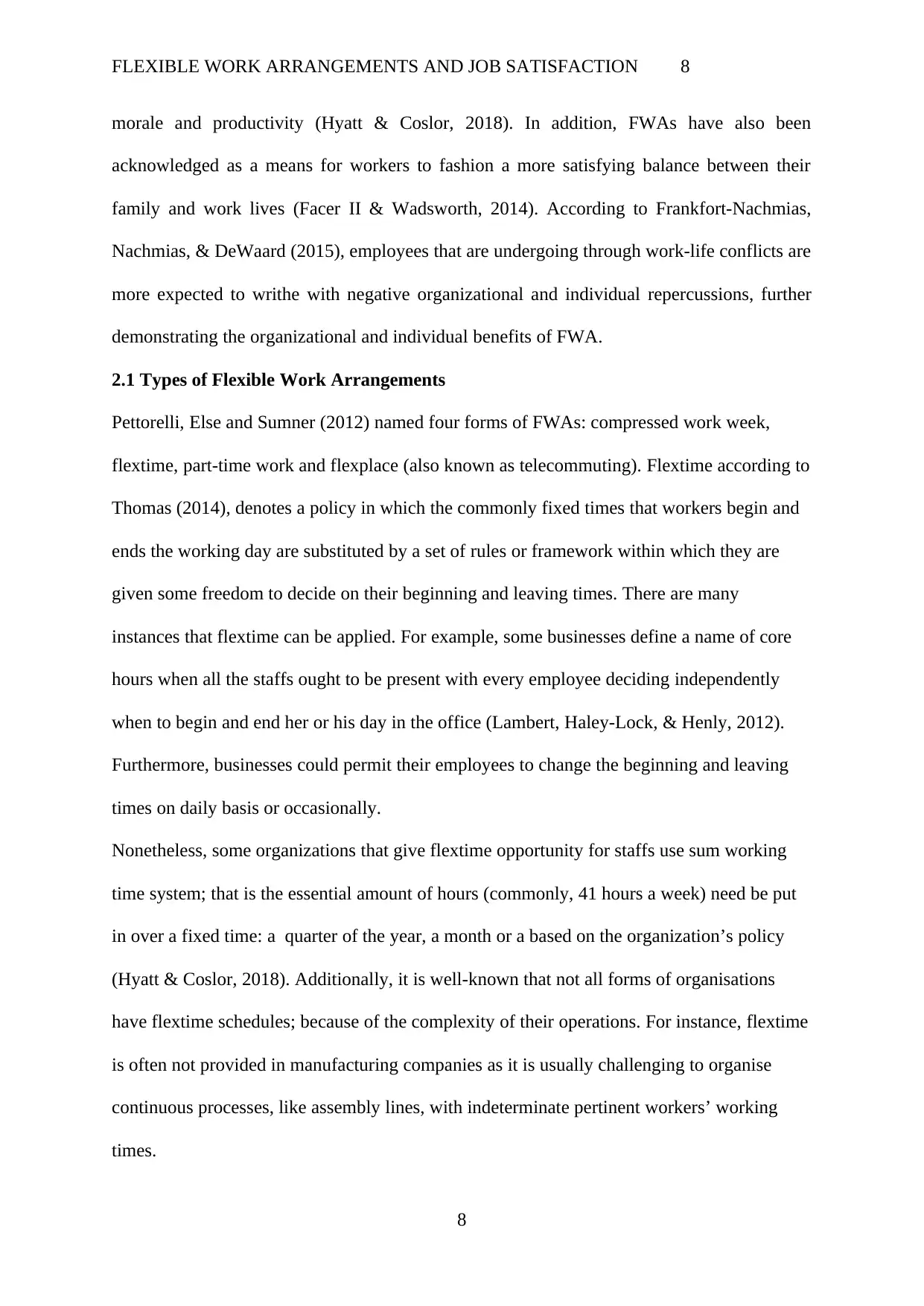
FLEXIBLE WORK ARRANGEMENTS AND JOB SATISFACTION 8
morale and productivity (Hyatt & Coslor, 2018). In addition, FWAs have also been
acknowledged as a means for workers to fashion a more satisfying balance between their
family and work lives (Facer II & Wadsworth, 2014). According to Frankfort-Nachmias,
Nachmias, & DeWaard (2015), employees that are undergoing through work-life conflicts are
more expected to writhe with negative organizational and individual repercussions, further
demonstrating the organizational and individual benefits of FWA.
2.1 Types of Flexible Work Arrangements
Pettorelli, Else and Sumner (2012) named four forms of FWAs: compressed work week,
flextime, part-time work and flexplace (also known as telecommuting). Flextime according to
Thomas (2014), denotes a policy in which the commonly fixed times that workers begin and
ends the working day are substituted by a set of rules or framework within which they are
given some freedom to decide on their beginning and leaving times. There are many
instances that flextime can be applied. For example, some businesses define a name of core
hours when all the staffs ought to be present with every employee deciding independently
when to begin and end her or his day in the office (Lambert, Haley-Lock, & Henly, 2012).
Furthermore, businesses could permit their employees to change the beginning and leaving
times on daily basis or occasionally.
Nonetheless, some organizations that give flextime opportunity for staffs use sum working
time system; that is the essential amount of hours (commonly, 41 hours a week) need be put
in over a fixed time: a quarter of the year, a month or a based on the organization’s policy
(Hyatt & Coslor, 2018). Additionally, it is well-known that not all forms of organisations
have flextime schedules; because of the complexity of their operations. For instance, flextime
is often not provided in manufacturing companies as it is usually challenging to organise
continuous processes, like assembly lines, with indeterminate pertinent workers’ working
times.
8
morale and productivity (Hyatt & Coslor, 2018). In addition, FWAs have also been
acknowledged as a means for workers to fashion a more satisfying balance between their
family and work lives (Facer II & Wadsworth, 2014). According to Frankfort-Nachmias,
Nachmias, & DeWaard (2015), employees that are undergoing through work-life conflicts are
more expected to writhe with negative organizational and individual repercussions, further
demonstrating the organizational and individual benefits of FWA.
2.1 Types of Flexible Work Arrangements
Pettorelli, Else and Sumner (2012) named four forms of FWAs: compressed work week,
flextime, part-time work and flexplace (also known as telecommuting). Flextime according to
Thomas (2014), denotes a policy in which the commonly fixed times that workers begin and
ends the working day are substituted by a set of rules or framework within which they are
given some freedom to decide on their beginning and leaving times. There are many
instances that flextime can be applied. For example, some businesses define a name of core
hours when all the staffs ought to be present with every employee deciding independently
when to begin and end her or his day in the office (Lambert, Haley-Lock, & Henly, 2012).
Furthermore, businesses could permit their employees to change the beginning and leaving
times on daily basis or occasionally.
Nonetheless, some organizations that give flextime opportunity for staffs use sum working
time system; that is the essential amount of hours (commonly, 41 hours a week) need be put
in over a fixed time: a quarter of the year, a month or a based on the organization’s policy
(Hyatt & Coslor, 2018). Additionally, it is well-known that not all forms of organisations
have flextime schedules; because of the complexity of their operations. For instance, flextime
is often not provided in manufacturing companies as it is usually challenging to organise
continuous processes, like assembly lines, with indeterminate pertinent workers’ working
times.
8
⊘ This is a preview!⊘
Do you want full access?
Subscribe today to unlock all pages.

Trusted by 1+ million students worldwide
1 out of 51
Related Documents
Your All-in-One AI-Powered Toolkit for Academic Success.
+13062052269
info@desklib.com
Available 24*7 on WhatsApp / Email
![[object Object]](/_next/static/media/star-bottom.7253800d.svg)
Unlock your academic potential
Copyright © 2020–2025 A2Z Services. All Rights Reserved. Developed and managed by ZUCOL.





